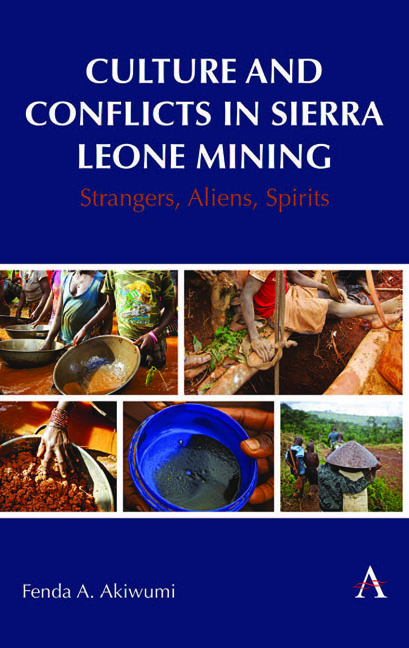Book contents
- Frontmatter
- Dediation
- Contents
- List of Figures and Tables
- Acknowledgements
- Abbreviations
- 1 Introduction: Culture in Commodity Chains
- 2 Sierra Leone’s Global Incorporation Through Mining
- 3 Cultural Difference: Policy and Legislative Dilemmas
- 4 Sacred Places: Local Ontology Meets Global Capital
- 5 Strangers, Environment, and Livelihoods
- 6 Race, Ethnicity, Class, and Gender in Mining
- 7 Between a Rock and a Hard Place
- 8 Conclusion
- References
- Index
2 - Sierra Leone’s Global Incorporation Through Mining
Published online by Cambridge University Press: 13 April 2024
- Frontmatter
- Dediation
- Contents
- List of Figures and Tables
- Acknowledgements
- Abbreviations
- 1 Introduction: Culture in Commodity Chains
- 2 Sierra Leone’s Global Incorporation Through Mining
- 3 Cultural Difference: Policy and Legislative Dilemmas
- 4 Sacred Places: Local Ontology Meets Global Capital
- 5 Strangers, Environment, and Livelihoods
- 6 Race, Ethnicity, Class, and Gender in Mining
- 7 Between a Rock and a Hard Place
- 8 Conclusion
- References
- Index
Summary
Historically, people throughout western Africa believed that smiths possessed redoubtable skills and powers. Only they knew the secrets of iron making and could secure the permission of the spirits of land, water, and forest to mine ores; only they could fell appropriate trees for charcoal making; and only they could invoke the spirits’ cooperation in the smelting and forging of iron. Successful ironworking required the application of the smiths’ considerable technological expertise, together with unremitting attention to requisite rituals. (Brooks 2003, 30)
Often when people think of Sierra Leone and mining, the first thought that comes to mind is conflict or blood diamonds. But there is much more than diamonds. The focus has been on diamond mining and the relationship with the warring factions of the large-scale Revolutionary United Front of Sierra Leone (RUF/SL) “blood diamond” war, 1991–2001, and its aftermath (Abdullah 2004; Fanthorpe and Maconachie 2010; Fanthorpe 2001; Jackson 2006; King 2007; Rashid 2004; Richards 2005). Researchers have analyzed the blood diamond war using a variety of conceptual frameworks such as the political economy (Hirsch 2001), the role of disenfranchised rural and urban youth, the so-called lumpen, as illegal diamond miners, and subsequently fighters in the RUF/SL war (Rashid 2004) greed, grievance, and governance (e.g., Bøås 2014; Frost 2012; Peters 2011). Others have written about the marginalization of youth within a gerontocratic system of traditional governance (Richards 2002) and the resource curse and actor– network theory (Wilson 2013). However, other minerals also played a role early on in Sierra Leone's global incorporation process and this continues today. Some minerals like iron ore and gold were mined by local people using artisanal methods of extraction for centuries (Goucher 1981; Wilson and Marmo 1958). I go beyond diamonds to address conflicts in other mineral extraction environments and in particular to highlight persistent low-level and smaller-scale conflicts that periodically turn violent.
Indigenous Artisanal Mining
Seventy percent of the Sierra Leone landmass contains mineral-rich basement rocks of the West African craton and supracrustal greenstone formations. A dense drainage network eroded and deposited alluvial deposits of minerals from the underlying rocks.
- Type
- Chapter
- Information
- Culture and Conflicts in Sierra Leone MiningStrangers, Aliens, Spirits, pp. 19 - 34Publisher: Anthem PressPrint publication year: 2024

